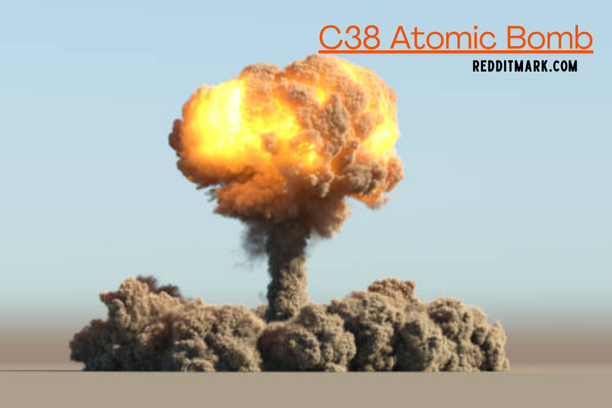Introduction
The C38 atomic bomb represents a full-scale milestone in the field of nuclear weapons. Understanding C38 is essential to understanding the broader implications of atomic bombs for global security, naval approach, and moral considerations. This article will dive deep into the C38 Atomic Bomb’s records, upgrades, technical specifications, strategic importance and many other aspects to provide a comprehensive assessment of this ambitious weapon.
History of atomic bombs
Early development
The origins of atomic bombs date back to the early 20th century, with key clinical breakthroughs through pioneers such as Albert Einstein and Enrico Fermi, who laid the groundwork for nuclear fission. The discovery of the neutron by James Chadwick in 1932 and the subsequent realization that bombarding uranium with neutrons could motivate a chain reaction set the stage for the development of atomic bombs. This duration was marked by a path of serious scientific curiosity and rapid progress in information atomic theory.
The Manhattan Project
During World War II, the US embarked on the Manhattan Project, a top secret initiative that culminated in the development of the primary atomic bombs, Little Boy and Fat Man, which were dropped on Hiroshima and Nagasaki in 1945. The Manhattan Project became a massive effort involving one hundred and thirty,000 people and cost nearly $2 billion (equivalent to about $23 billion today). He brought together some of the best scientific minds of the time and caused the successful development of primary nuclear weapons, marking a turning point in today’s conflict.
The development of nuclear weapons
After World War II, nuclear weapons evolved greatly, with advances in this era leading to more sophisticated and powerful bombs, including the hydrogen bomb and numerous tactical nuclear weapons. The Cold War generation fueled the nuclear arms race between America and the Soviet Union, which led to the development of a variety of nuclear weapons with varying yields and delivery patterns. Innovations, along with multiple independently targetable reentry vehicles (MIRVs) and advanced guidance structures, further require the strategic capabilities of nuclear arsenals.
Introduction to the C38 Atomic Bomb
What is the C38 Atomic Bomb?
The C38 Atomic Bomb represents a modern generation of nuclear weaponry, proposing a superior era and stronger damaging abilities. It is the result of many years of research and improvement, incorporating modern materials and layout ideas to gain maximum efficiency and effect. The C38 isn’t just a weapon however an image of the technological prowess and strategic thinking of the kingdom that possesses it.
Key Features of the C38
Key capabilities include its compact design, advanced detonation mechanism and improved yield compared to earlier atomic bombs. The compact design allows for easier deployment and transport, making it more versatile in multiple situations. An excellent detonation mechanism ensures a reliable and powerful explosion, maximizing the negative capacity of the bomb. These improvements make the C38 atomic bomb a formidable tool in a nation’s navies’ arsenal, capable of influencing global power dynamics.
Differences between C38 and other atomic bombs
Unlike its predecessors, the C38 atomic bomb incorporates state-of-the-art materials and generation, resulting in exceptional performance and reliability. It also boasts a larger state-of-the-art transportation machine with a special focus in mind. These differences make the C38 atomic bomb not only more effective, but also more strategic, allowing it to be used in a wider range of Army operations. The superior features of the C38 set it apart from other non-ready-made atomic bombs, highlighting the continued evolution of the nuclear weapons era.
Development and testing
Research and development phase
The development of the C38 atomic bombconcerned enormous study and collaboration among Navy scientists, engineers, and professionals. This segment focused on refining the bomb’s layout and increasing its damaging electricity. Research groups have worked tirelessly to conquer technically demanding situations and ensure that the C38 meets stringent performance and protection requirements. Collaboration between different fields of knowledge became vital in growing a bomb that was powerful and reliable.
Test sites and procedures
C38 atomic bomb testing has changed to being conducted in remote locations to provide some protection and reduce environmental impact. These tests were carefully thought out and carried out to obtain a complete record of the bomb’s performance. Test approaches covered a chain of controlled detonations, simulations and environmental assessments to assess the bomb’s effect. The facts obtained from these tests provided valuable insights that led to further improvements and upgrades to the C38 atomic bomb layout.
Test results
Inspections verified the C38 atomic bomb’s formidable adverse electricity and confirmed its status as one of the most advanced atomic bombs in existence. In addition, the collected facts provided insights for further improvements and refinements. The test results confirmed that the C38 exceeded performance expectations and turned into an effective explosion with a huge range of effect. These effects underscored the bomb’s ability as a strategic deterrent and naval asset.
Technical Specifications
Composition of the C38 Bomb
The C38 atomic bomb is composed of a plutonium middle, surrounded using traditional explosives and a tamper to decorate the nuclear response. The substances used are decided on for their stability and effectiveness. The bomb’s design guarantees that the nuclear reaction is initiated efficiently, maximizing the yield and effect of the explosion. The use of superior substances additionally complements the bomb’s reliability and safety, reducing the threat of unintentional detonation.
Mechanism of Detonation
The C38 atomic bomb employs an implosion-type detonation mechanism, wherein traditional explosives compress the plutonium middle, initiating a nuclear chain reaction. This layout guarantees a higher yield and greater managed explosion. The implosion mechanism is a hallmark of contemporary nuclear weapons, offering a dependable and green way to trigger the nuclear reaction. The C38’s detonation mechanism is carefully engineered to make certain particular timing and maximum impact.
Yield and Impact Radius
The yield of the C38 atomic bomb is significantly better than earlier atomic bombs, with an envisioned yield of numerous megatons. Its impact radius extends numerous miles, causing enormous destruction and long-lasting environmental outcomes. The bomb’s powerful explosion can obliterate buildings, and infrastructure, and purpose significant casualties. The lengthy-term environmental effect consists of radiation fallout, that could contaminate massive regions and pose serious health risks to survivors.
Strategic Importance
Military Significance
In the army context, the C38 atomic bomb is a powerful deterrent, able to dissuade potential aggressors. Its advanced features also make it a critical factor in a nation’s defense method. The presence of this kind of weapon in a kingdom’s arsenal can affect the strategic calculations of other countries, potentially stopping conflicts through the risk of overwhelming retaliation. The C38’s army’s importance lies in its capability to provide a credible and ambitious deterrent.
Role in Deterrence
The mere lifestyles of the C38 can deter opposed movements from other nations, as the capability consequences of its use are devastating. This deterrence plays an essential function in preserving worldwide peace and balance. The idea of deterrence is based totally on the concept that the danger of excessive retaliation can prevent adversaries from starting up conflicts. The C38’s advanced abilities decorate its deterrent effect, contributing to solid and secure global surroundings.
Influence on Global Politics
The C38’s improvement and deployment have considerable implications for global relations, influencing diplomatic negotiations and strength dynamics amongst nations. The ownership of superior nuclear guns can provide a country with multiplied leverage in worldwide boards, shaping the effects of negotiations and agreements. The C38s have an effect on extends past military concerns, affecting geopolitical strategies and alliances.
Ethical and Environmental Concerns
Ethical Implications of Atomic Bomb Use
The use of atomic bombs increases profound moral questions, mainly concerning civilian casualties and long-term health results. The morality of deploying such guns is still a topic of severe debate. Critics argue that the humanitarian effect of nuclear guns is unacceptable, given the indiscriminate nature of their destruction. The ethical implications of the C38’s use must be carefully considered, weighing the capacity benefits in opposition to the extreme human and environmental prices.
Environmental Impact
The detonation of an atomic bomb has severe environmental consequences, which include radiation fallout, contamination of herbal sources, and long-term ecological harm. The environmental impact extends some distance beyond the on-the-spot region of the explosion, affecting ecosystems and human fitness for generations. The C38’s powerful explosion can create a “nuclear wintry weather” situation, where soot and debris block sunlight, leading to drastic weather adjustments and agricultural disintegration.
Long-time period Consequences
The lengthy-term outcomes of atomic bomb use expand beyond instantaneous destruction, affecting generations through radiation illness, genetic mutations, and environmental degradation. Survivors of atomic bomb explosions face improved dangers of cancer, birth defects, and different fitness issues. The lengthy time period environmental effect can render massive regions uninhabitable, main to displacement and monetary demanding situations. The C38’s use would have profound and lasting effects on each human and ecological structure.
Deployment Scenarios
Potential Use Cases
The C38 could be deployed in numerous scenarios, along with strategic moves, deterrent shows, and as an ultimate lodge in complete-scale conflicts. Each use case incorporates huge dangers and consequences. Strategic moves contain targeting military centers or infrastructure, aiming to cripple the enemy’s competencies. Deterrent shows may additionally contain exams or demonstrations to exhibit the bomb’s electricity and deter capability adversaries. Full-scale conflicts should see the C38 used as an ultimate inn, with devastating consequences.
Historical Deployment of Similar Weapons
Historical times, which include the bombings of Hiroshima and Nagasaki, provide stark reminders of the devastating effect of atomic bombs. These activities underscore the gravity of deploying such guns. The bombings resulted in a sizeable loss of lifestyles, excessive accidents, and long-term health effects for survivors. They additionally highlighted the moral and ethical concerns related to using nuclear guns and influencing global policies and public opinion.
Conclusion
In the end, the C38 Atomic Bomb represents no longer just a technological marvel but additionally a profound symbol of the complexities and demanding situations inherent in nuclear weaponry. Its improvement and skills underscore the relentless pursuit of military superiority and strategic deterrence inside the contemporary global.
Throughout records, from the Manhattan Project to the modern, atomic bombs have reshaped global dynamics, influencing army strategies, global members of the family, and ethical debates. The C38, with its superior design and bold energy, keeps this legacy, posing critical questions about protection, morality, and the destiny of warfare.



